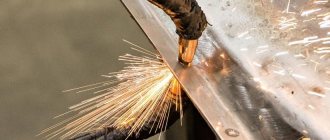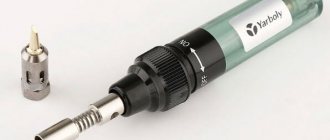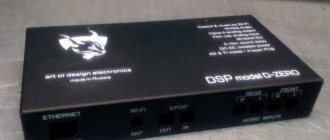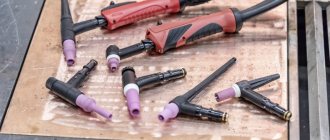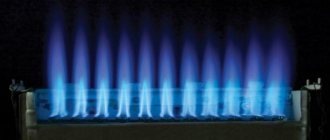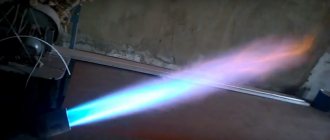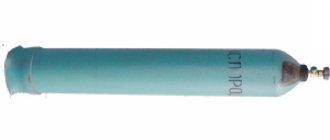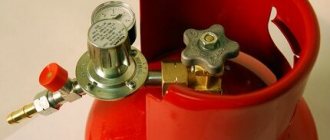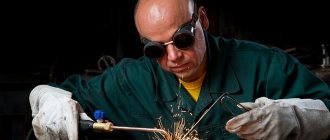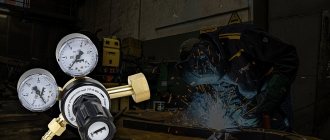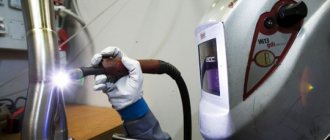When choosing technical gas, enterprises, first of all, are guided by the fact that the organization of various technological processes requires flammable gases with different characteristics. The main ones are flame power and temperature, oxygen consumption and areas of gas use.
For metal cutting, welding and other similar processes, an indicator such as flame power plays an important role. Also of great importance is the ability of the flame to transfer energy to the exposed material. In this regard, technical acetylene is better than propane, since its use allows you to create a flame that will quickly heat the metal surface to the required temperature.
The time it takes to complete the work depends on the temperature that the flame produced using technical gas can reach. Therefore, it is very important for the surface heating process. In this regard, again good results can be achieved using acetylene. While propane flame temperatures can reach 2,800 degrees Celsius, acetylene heats up to 3,100 degrees Celsius. However, acetylene is significantly inferior to propane in terms of energy reserve: 55 versus 95 MJ/m3.
To use technical gases, different amounts of oxygen are required. For acetylene, 1.1 cubic meters is enough to form a flame normal for the work, and for propane, almost four cubic meters of oxygen are required.
Another positive feature of acetylene is that its composition can be changed to result in a reducing or neutral fire. All other gases, including propane, at the temperatures required for industrial purposes, can only form an oxidizing type flame. Therefore, welding cannot be done with propane.
But if it is necessary to carry out general heating of a metal surface, then you cannot do without propane. This thermal process requires gas with a significant energy reserve per cubic meter. Propane gas has these properties.
To summarize, we note that acetylene is good because it can be used in oxidative, neutral and reduction processes when hardening, cutting and welding metals. It is highly effective in carrying out processes that need to be interrupted. It can also be used on contaminated surfaces.
In turn, propane is distinguished by its availability, since it can be supplied in both containers and cylinders. It is effective in general surface heating and the risk of blowback is quite low when used.
Home page » Metalworking » Gas cutting of metal » What you need to know about gas cutters for metal: portable and conventional, about the design and settings
Gas cutters are used for cutting metal sheets, parts and assemblies into individual parts of various sizes, up to small blanks for jewelry.
Such equipment is widely used to perform the following work:
- preparatory work in the procurement areas of metalworking production (from jewelry manufacturing to heavy engineering);
- repair: from home renovation to car repair;
- during the construction of a variety of objects, etc.
Burners, cutters, reducers, cylinders, electrodes
Gas welding is used to heat metal with a high-temperature flame resulting from the combustion of flammable acetylene gas mixed with oxygen.
In some cases, instead of acetylene, its substitutes can be used: propane-butane, methane, gasoline or kerosene vapor, MAF (methyl acetylene-allen fraction). The main advantage of gas welding is that it does not require a source of electricity or additional expensive equipment. Welding can be done even in the field. Gas welding is especially convenient when welding small-diameter pipes in hard-to-reach places.
An acetylene torch is the main tool for manual gas welding. In the burner, oxygen and flammable gas (acetylene, propane) are mixed in the required proportions. The resulting mixture flows out of the torch mouthpiece channel and burns, producing a stable flame that melts the base and filler metal at the welding site.
Welding torches , brought to your attention, allow you to perform not only manual welding, but also soldering, heating ferrous and non-ferrous metals and alloys using a gas flame. The burners have a simple and repairable design and are equipped with replaceable tips for different thicknesses of metals. Certified, reliable and safe to operate, subject to basic operating rules.
Gas welding equipment
The kit for gas welding or cutting includes:
- burner or cutter;
- oxygen and acetylene hose;
- oxygen balloon;
- acetylene generator or propane cylinder;
- gearboxes.
Every detail of a gas apparatus is of great importance, and it is impossible to do without it. But you can put together a set of apparatus for gas welding, buying devices gradually, replacing them, selecting the necessary parameters.
Operating principle and types
Regardless of the size of the autogen and the type of heating gas mixture, cutting occurs due to the combustion of metal in a stream of pure oxygen pumped through the head nozzle into the working area.
The main and fundamental condition for gas cutting is that the combustion temperature must be less than the melting temperature. Otherwise, the metal, before it starts to burn, will melt and drain. Low-carbon steels meet this condition, but non-ferrous metals and cast iron do not.
Most alloy steels are also not amenable to gas cutting - there are restrictions on the maximum permissible doses of alloying elements, carbon and impurities, above which the process of metal combustion in oxygen becomes unstable or is completely interrupted.
The cutting process itself can be divided into two phases:
- Heating a limited area of a part to a temperature at which the metal begins to burn. And in order to obtain a torch of a heating flame, part of the technical oxygen is mixed in a certain proportion with combustible gas.
- Combustion (oxidation) of heated metal in a stream of oxygen and removal of combustion products from the cutting zone.
If we consider the classification of only hand cutters, then the following features are of fundamental importance:
- type of fuel, power and method of producing a mixture of gases for a heating flame;
- classification by type of flammable gas: acetylene, propane-butane, methane, universal, MAF.
Kerosene cutters and gas cutters, although they have the same purpose, are classified as liquid fuel cutters.
- By power: low (cutting metal with a thickness of 3 to 100 mm) - marking P1, medium (up to 200 mm) - P2, high (up to 300 mm) - P3. There are samples with increased cutting thickness - up to 500 mm.
- According to the method of producing flammable gas: injection and non-injector.
And if the first sign affects only the temperature of the heating flame, and the power affects the maximum thickness of the metal, then the third sign is determined by the design of the cutter.
Design
1. An injection or two-pipe gas cutter is the most common type of design. Technical oxygen in the cutter is divided into two streams.
Part of the flow through the top tube moves into the tip head and exits at high speed through the central nozzle of the inner mouthpiece. This part of the structure is responsible for the cutting phase of the process. The control valve or lever valve is located outside the housing.
The other part goes into the injector. The operating principle of which is that the injected gas (oxygen), entering the mixing chamber under high pressure and at high speed, creates a rarefaction zone there and draws in flammable (injected) gas through the peripheral holes. Thanks to mixing, the velocities are equalized, and at the exit of the chamber a flow of a mixture of gases is formed at a speed lower than that of the injected oxygen, but higher than that of the ejected combustible gas.
Next, the mixture of gases moves along the lower tube into the head of the tip, exits through the nozzles between the inner and outer mouthpiece, and forms a torch of a heating flame. Each channel has its own valve on the body, which regulates the supply of oxygen and combustible gas to the injector.
2. A non-injector or three-pipe cutter has a more complex design - both oxygen flows and gas flow to the head through separate tubes.
Mixing of the heating mixture occurs inside the head. But it is precisely the absence of a mixing chamber that provides a higher level of safety and does not create conditions for “backlash” (propagation of burning gases in the cutter channels and pipes in the opposite direction).
Acetylene generators
Welding generators produce acetylene, which is obtained by combining calcium carbide with water. Such devices are mobile and stationary. Based on output pressure, they are divided into 3 categories:
low pressure generators up to 0.1 atmosphere;- average from 0.7 to 1.5 atm.;
- high pressure over 1.5 atmospheres.
In this case, the devices can produce from 0.3 m3 to 160 m3 of acetylene per hour.
Based on the method of producing gas, generators are divided into five types:
"KV". In these generators, carbide enters the water in small portions. When the pressure drops below the threshold, a new portion of carbide arrives. The slaked calcium carbide is removed through the bottom outlet valve. Due to its large dimensions it is used in stationary installations. Has the highest yield of acetylene.
"VC". Here the water hits the carbide. Water is supplied in small portions as the pressure decreases. This method is called “wet VC”. The device has a simple and reliable design. Capacity up to 10 m3. The disadvantage is incomplete quenching of calcium carbide.
"VK" for dry process. Water is supplied into the chamber with calcium carbide in doses. When acetylene is formed, heat is released, which evaporates excess water. Due to this, the hydrated carbide turns out dry. Hence the name.
"BB". In generators of this type, gas is produced by displacing water from the gas generation chamber with a basket of calcium carbide. When the pressure drops, the displaced water flows back into the chamber. The device is used in mobile welding stations.
"PC". The generators use a combined principle of gas production. Two methods are combined: “water on carbide” and “water displacement”. Used in mobile installations. Has smooth adjustment of gas supply.
Universal gas cutter
Often we are talking about cutters with intra-nozzle gas mixing. Separately, it is necessary to highlight universal gas cutters. Experts prefer universal models due to the possibility of their wide application when cutting metal using various types of flammable gases.
Advantages of universal gas cutters
- they cut products with both propane and acetylene (when changing the mouthpiece);
- are as simple and easy to use as possible;
- are light in weight;
- designed for cutting material with a thickness from 3 mm to 300 mm.
The most popular are universal cutters.
There are different types of cutters for manual and machine cutting. Read more about gas cutting machines.
The online store offers its customers favorable terms of cooperation. If you need detailed advice on the range of products, contact our specialists by phone or leave a request on the website.
Gas cutter for metal: varieties
Gas cutters are divided into types according to various parameters. The main ones are the following:
- by type of flammable gas: acetylene;
- methane;
- propane-butane, etc.
- non-injector;
- for cutting under water;
- spear;
Currently, the most popular gas cutters are the universal type. They are distinguished by the following positive qualities:
- carry out cutting in any direction with material thickness, mm: 3…300;
- quite easy to use;
- very stable;
- withstands reverse impacts well;
- have a small mass.
Propane
A propane gas cutter can cut metal sheets up to 300 mm thick. The equipment has a whole set of technical characteristics that contribute to its long-term operation. Many parts are easily replaceable and, if necessary, can be replaced directly during the work process (without leaving the work site). In most cases, replacement with analogues is possible. In addition, propane has a relatively low cost. This makes using propane cutters even more beneficial.
As an example, consider the Mayak 2-01 and RS-3P propane burners.
"Mayak 2-01" is used for manual separation and oxygen cutting of low-alloy and carbon steels.
Its technical characteristics:
- thickness of cut steel, mm: 3…100;
- flammable gas: propane;
- sleeve diameter, mm: 9/9;
- length, mm: 580;
- weight, kg: 1.3.
Propane mouthpieces supplied:
- external No. 1;
- internal No. 1 (for cutting metal thickness, mm: 8...15) – installed on the cutter;
- spare parts included: No. 2 (15...30 mm);
- No. 3 (30...50 mm);
- No. 4 (50...100 mm).
“RS-3P” is an oxygen-gas injection gadget designed for manual cutting of low-alloy and carbon steels.
Its technical characteristics:
- thickness of cut steel, mm: ≤ 200;
- gas used: propane / methane;
- length, mm: 500;
- climatic version: UHL 1 and T 1 according to GOST 15150;
- operating temperature, °C: when working on acetylene: + 45…minus 40;
- when working on propane-butane: +45ºС…minus 15;
Acetylenic
Acetylene cutters are designed for manual separation, oxygen-acetylene cutting of carbon and low-alloy steels. Classic ones are injection-type cutters:
- "P1-01";
- "R2-01";
- "R2A-02";
- "Mayak-1-01".
The mixing of gases in them occurs in the injection chamber, which is located near the handle.
The thickness of the metal cut by this equipment depends on the number of the mouthpieces on the cutter:
- type P1 (for example, “P1-01”) are equipped with mouthpieces that allow cutting metal up to 50 mm thick;
- type P2 (“P2-01”, “Mayak-1-01”) are equipped with mouthpieces that provide cutting of metal up to 200 mm thick.
Portable cutting torch
Many had the opportunity to observe the hard work of gas welders, transporting large and heavy cylinders with flammable gas and oxygen to the workplace on various carts. To create mobility, the cutter is connected to the cylinders via long hoses. It is inconvenient and quite difficult to work with such a device. Moreover, it is these long hoses that create the greatest inconvenience.
What is oxygen cutting?
In oxyfuel cutting, the flame of the oxygen-fuel mixture preheats the steel to its ignition temperature.
A stream of oxygen is directed at the metal, creating a chemical reaction to form iron oxide, also known as slag. A powerful flow of oxygen removes slag from the cut.
When using oxy-fuel torches, cut quality, preheat time and metal thickness depend on the type of fuel gas. The process uses one of four fuel gases in combination with oxygen: acetylene, propane, propylene and natural gas.
What is oxygen cutting used for?
Manual oxygen cutting is common in low-volume projects when the use of expensive units is not economically justified. For example, preparing parts for subsequent forging and stamping, in foundries, cutting pipes. Oxygen cutting is effective when working with thick steel and ferrous metals.
There are oxy-fuel torches that can be used for several processes such as cutting, welding and soldering.
Advantages of oxygen cutting:
- The undeniable advantage of this process is the low initial costs and portability of components compared to plasma cutting machines.
- The ability to quickly cut thicker steel, in addition to the versatility of the system.
An oxy-fuel injection cutter consists of two main parts - a barrel and a tip. The barrel consists of a handle with nipples for connecting oxygen and gas hoses, a body with oxygen and gas control valves, an injector, a mixing chamber, a tube, a cutter head with an internal and external mouthpiece, a cutting oxygen tube with a valve. The barrel is connected to the body with a union nut.
Oxygen from the cylinder enters the cutter through a reducer and a hose with nipples and branches into two channels in the housing. Part of the gas, passing through the valve, is directed to the ejector. Coming out of the ejector at high speed, a stream of oxygen creates a vacuum and sucks in flammable gas, which forms a flammable mixture with oxygen in the mixing chamber, which, passing through the gap between the outer and inner mouthpieces, burns, forming a heating flame.
The other part of the oxygen enters the cutting oxygen tube through the valve, leaving through the central channel of the internal mouthpiece, forming a jet of cutting oxygen. The main part of the cutter is the mouthpiece and nozzle, which quickly wear out during the cutting process. To obtain a high-quality cut, it is necessary to have the correct dimensions of the nozzle and mouthpiece. The correct ratio of gas supply pressure with the appropriate metal thickness. It is also necessary not to forget about constant maintenance and cleaning of the nozzle channels with copper rods.
Features of gas welding
The technology of gas welding and cutting on the appropriate apparatus has its own nuances depending on the characteristics of the metal. Welding of low-carbon alloys is done with any gas.
When gas welding alloy steels, wire containing chromium and nickel is used. Cast iron products are cooked with a special flame that prevents the formation of white cast iron.
When gas welding copper objects, the gap should be minimal and the flame should be high power. Copper filler wire and deoxidizing flux are used. Brass products are welded with a high supply of oxygen using brass wire.
